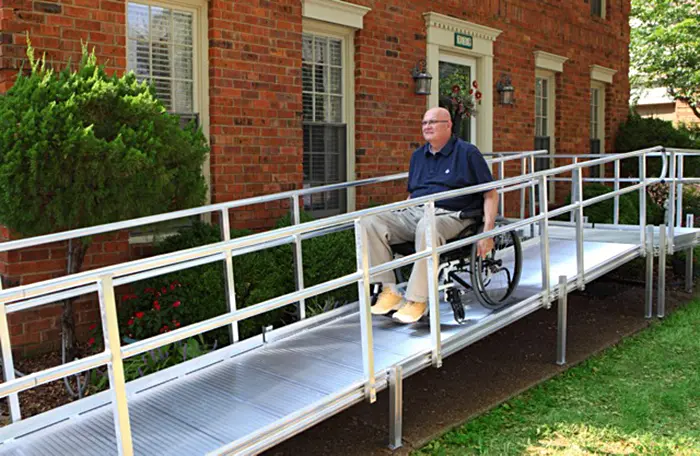Designing inclusive living spaces requires a delicate blend of precision and foresight. When it comes to installing home ramps, a key element in promoting inclusivity and well-being, the focus shifts to practical guidelines and strategic business approaches. By demystifying the complexities of integrating ramps seamlessly into homes while aligning with broader accessibility objectives, a comprehensive method emerges.
Businesses can harness these installations not only to meet regulatory requirements but also to elevate the overall living experience, presenting a roadmap for crafting spaces that prioritize health, accessibility, and visual appeal.
Key Takeaways
- Assessment and planning are crucial steps in the installation process for home ramps.
- Prioritizing health, accessibility, and regulatory compliance is essential for creating healthy and accessible living spaces.
- Home ramps promote independence, inclusivity, and enhance the quality of life for individuals with mobility issues.
- Safety measures such as proper ramp design, handrails, non-slip surfaces, and adequate lighting are vital for ensuring the safety of home ramps.
Importance of Home Ramps
The significance of incorporating home ramps into living spaces cannot be overstated, as they play a crucial role in promoting accessibility and independence for individuals with mobility challenges. Home ramps provide a practical solution for those with mobility issues, allowing them to navigate their living environment with ease and confidence. By installing home ramps, individuals can move freely between different areas of their home, such as entrances, exits, and various levels, without facing barriers or restrictions. This increased accessibility not only enhances the quality of life for individuals with mobility challenges but also fosters a sense of belonging and inclusivity within the community.
Moreover, home ramps offer a sense of independence and empowerment, enabling individuals to maintain their autonomy and carry out daily activities without assistance. Having a ramp at home means individuals can come and go as they please, engage in social gatherings, and access essential services without feeling dependent on others. In essence, the presence of home ramps contributes significantly to creating a more inclusive and accommodating living space that caters to the diverse needs of all residents.

Factors to Consider
When evaluating the installation of home ramps, it is imperative to carefully assess various key factors to ensure optimal accessibility and functionality.
Location:
- Consider the specific areas where ramps are needed, such as front entrances, back doors, or internal spaces.
Material Selection:
- Choose materials that are durable, weather-resistant, and non-slip to guarantee safety and longevity.
Slope and Design:
- Ensure the ramp slope adheres to accessibility guidelines for ease of use and that the design complements the existing architectural aesthetics of the home.
These factors play a crucial role in the effectiveness of the home ramps, enhancing the overall accessibility and usability of the living space. By addressing these considerations thoughtfully, individuals can create an environment that promotes inclusivity and independence for all residents and visitors.
It is essential to approach the installation process with a focus on both functionality and design to achieve a harmonious integration of the ramps within the home environment.
Step-by-Step Installation Guide
To ensure a seamless installation process for home ramps, meticulous planning and precise execution are essential steps towards creating accessible living spaces that cater to diverse mobility needs. Here is a step-by-step guide to assist you in installing home ramps effectively:
- Assessment and Planning: Begin by assessing the specific requirements of the individual using the ramp. Consider factors such as the slope, length, and width needed for safe and comfortable access.
- Selecting the Right Ramp: Choose a ramp that meets the necessary specifications and complies with accessibility guidelines. Ensure the ramp is sturdy, slip-resistant, and suitable for the intended location.
- Preparation: Prepare the installation site by clearing the area of any obstacles. Ensure that the surface is level and stable to prevent any accidents or damage.
- Installation: Follow the manufacturer’s instructions carefully to assemble and install the ramp securely. Double-check all connections and fastenings to guarantee stability.
- Safety Inspections: Conduct thorough safety inspections post-installation to ensure the ramp meets safety standards and functions correctly.
Ensuring Safety Measures
Ensuring safety measures during the installation of home ramps is paramount to creating a secure and accessible environment for individuals with diverse mobility needs. To guarantee the safety of those using the ramps, consider the following measures:
- Proper Ramp Design: Ensure that the ramp is designed with the appropriate slope and width to accommodate different mobility aids such as wheelchairs and walkers.
- Include Handrails: Installing sturdy handrails on both sides of the ramp can offer added support and stability for users.
- Non-Slip Surface: Use materials that provide a non-slip surface to prevent accidents, especially in wet or slippery conditions.
- Adequate Lighting: Ensure that the area around the ramp is well-lit to enhance visibility, especially during nighttime use.
Maintenance Tips
Following the essential safety measures during the installation of home ramps, it is crucial to maintain regular upkeep to ensure the longevity and functionality of the accessibility feature. Proper maintenance not only prolongs the life of the ramp but also ensures the safety of those using it. Here are some practical maintenance tips to keep your home ramp in top condition:
- Regular Inspections: Conduct routine checks to look for any signs of wear and tear, such as loose bolts, cracks, or uneven surfaces. Addressing these issues promptly can prevent accidents.
- Cleaning: Keep the ramp clean from debris, leaves, or any obstacles that may hinder its functionality. Regular cleaning can prevent slips and falls.
- Weather Protection: If your ramp is exposed to the elements, consider applying weather-resistant coatings to protect it from rain, snow, and UV rays.
- Lubrication: Ensure that movable parts, such as hinges and locks, are well-lubricated to prevent rust and corrosion.
Frequently Asked Questions
How Can Home Ramps Benefit Individuals With Mobility Challenges?
Home ramps benefit individuals with mobility challenges by providing easier access to their homes, promoting independence, safety, and inclusion. They offer a practical solution for navigating steps and thresholds, enhancing daily living and overall quality of life.
What Are Some Common Mistakes to Avoid When Installing Home Ramps?
When installing home ramps, common mistakes to avoid include improper slope angles, lack of sturdy handrails, inadequate landing space, and using poor quality materials. Ensuring these aspects are addressed will enhance safety and accessibility.
Are There Specific Regulations or Guidelines to Follow When Installing Home Ramps?
When installing home ramps, it is crucial to adhere to specific regulations and guidelines to ensure safety and accessibility. These may include slope gradients, width requirements, handrail specifications, and landing dimensions for a compliant installation.
How Often Should Home Ramps Be Inspected for Safety?
Home ramps should be inspected for safety at least once a year, with additional checks after extreme weather events or if any damage is suspected. Regular inspections ensure the ramp remains safe and accessible for all users.
What Are Some Innovative Design Options for Home Ramps to Enhance Accessibility and Aesthetics?
Innovative design options for home ramps to enhance accessibility and aesthetics include incorporating sleek handrails, non-slip surfaces with stylish patterns, and color contrast for visual guidance. These elements blend functionality and design seamlessly, ensuring a safe and appealing ramp.
Conclusion
In conclusion, the installation process for home ramps is crucial for creating healthy and accessible living spaces. By considering factors such as safety, functionality, and aesthetics, businesses can strategically enhance inclusivity and well-being within environments.
Following a step-by-step guide and implementing maintenance tips will ensure that home ramps serve their purpose effectively while maintaining a high standard of accessibility for all individuals.
You may also like to read:
Safe Builds, Happy Clients: The Advantages of a Safety-Focused Remodeling Business





